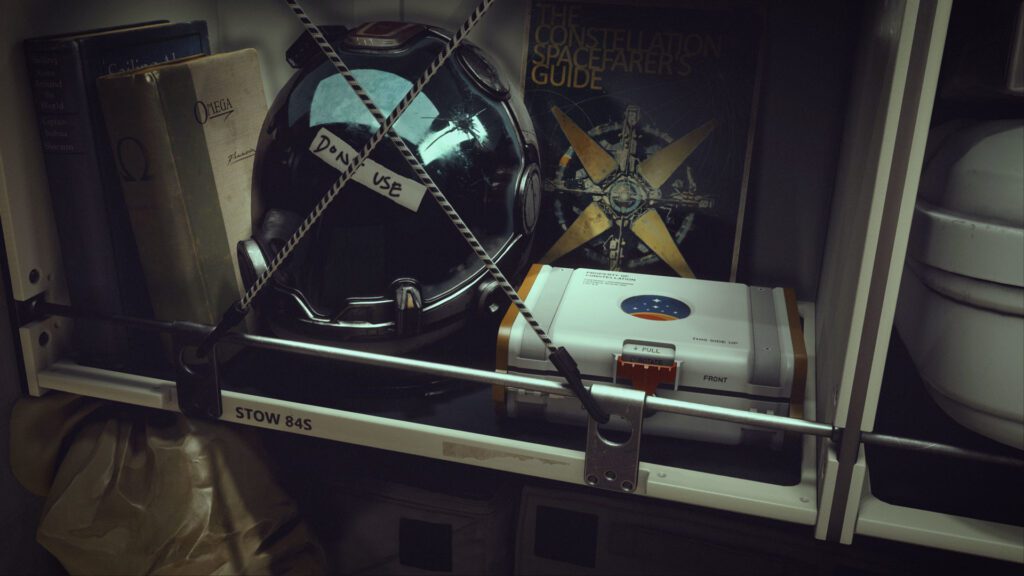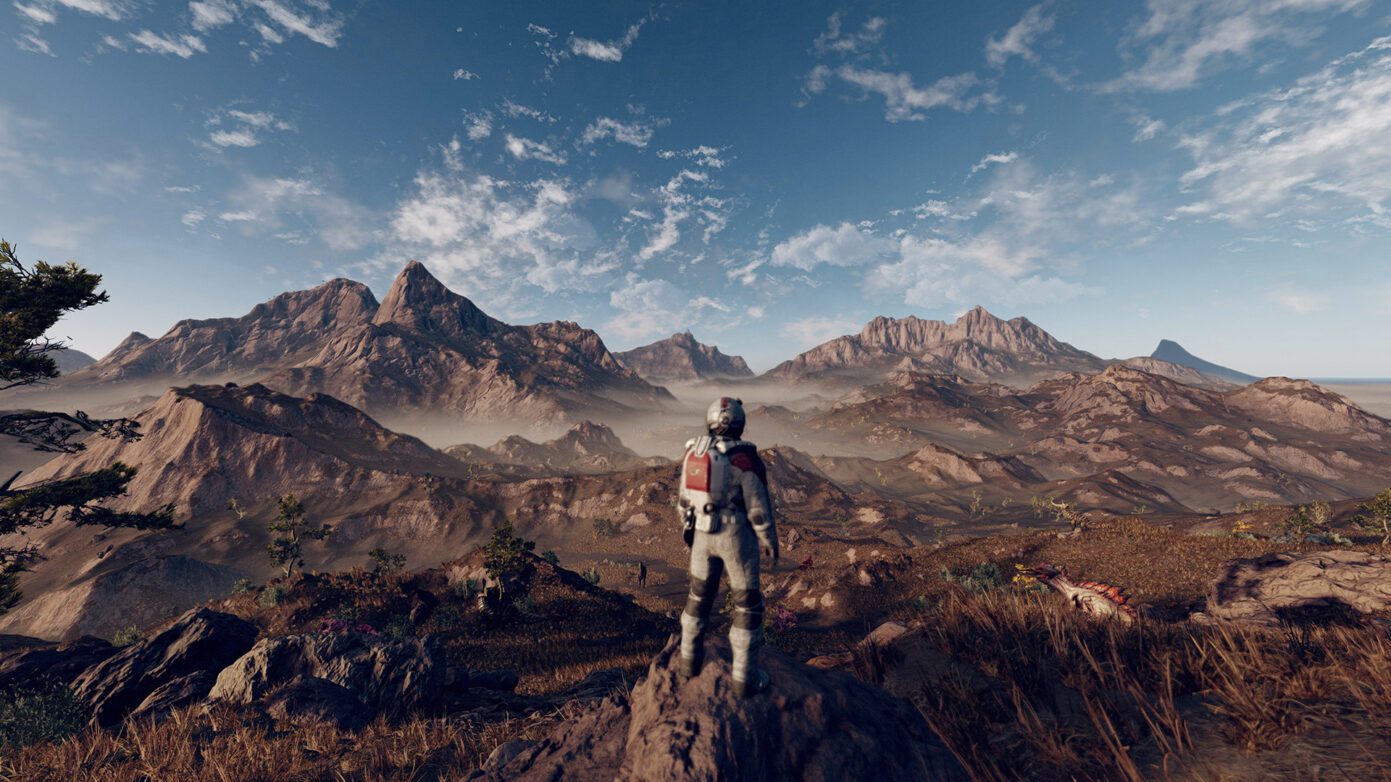Besthesda fans know that “a quarter century in the making” means closer to a decade. These kinds of exaggerated statements are common to the game studio. “Fallout 4 just works” was never entirely true, and plenty was overpromised for Skyrim and Fallout 76 too, but they’re all still fun open world RPGs nevertheless. The same stands here for Starfield, if your expectations haven’t been blown out of proportion and you’re expecting something like Skyrim in space, you’ll be pleasantly surprised.
Starfield Review – Lightyears of light fun
To organise the review here’s the topics I’ll touch on:
Mechanics
Incremental improvements
The new Creation Engine 2 is certainly a generational leap from previous games but the skeleton of Skyrim still stands strong within it: Random items will still stay wherever you left them no matter how much time or distance you put between visits; and quests are rarely more than checklists to follow along. The gunplay, healing, looting, hoarding, and companion systems have remained the same– which are all serviceable, but nothing to write home about– but there are two notable improvements: The ship systems, and the persuasion system.
Beyond just designing your ship to be a perfect replica of the Planetary Express ship, or something from Star Wars, the design and features of your ship is surprisingly useful. You can attach research labs, crew rooms, extra thrusters and even working windows. And when you’re out on the interplanetary prairie they all come in handy. Flying around in space on the other hand, isn’t so excellent. Instead of flying from one planet to the other naturally, you just fast travel. This means your piloting is limited to small zones off world. You jump to a planet, maybe do a little dogfighting, chat across the ham radio, or scavenge old wrecks then land for the real gameplay. That’s not to say that all that isn’t fun, just that it’s not a big portion of the game.
The persuasion system is a small addition, but coming off the back of Fallout 4 pretty weak charisma checks, it’s a real treat. Instead of a simple dice roll or a point check, you discuss with the person. Should they help you find the shipjacker you’re looking for? Well if they do you’ll promise their protection, or clear their debts, or stop your goon from strong-arming them. Some conversations are rough, others are subtle, but each selection will convince them a little more or else they’ll give up completely. The result is still either they agree or disagree, but it takes a lot more consideration and convincing to get there.
Dynamics
Relaxed spacefaring
Starfield can make you feel like a galactic hero, a smuggler, an interstellar vagabond, or practically anything else, but there is some assembly required. First you have to make it through the lengthy intro– starting the game with menial labour in a mine isn’t a stellar introduction– then get a grip on the various game systems. Both these things take some time, but it’s worth waiting for that airlock to open.
Once you’re free to roam the outer reaches, there’s cities, planets, star systems, and a galactic war to sort out. You can survey each planet, mapping out the outer systems, you can strong-arm freighters into handing over their valuables, and you can join the UC Vanguard to secure the stars. If you’re willing to use your imagination a little and get into the spirit of things, this sandbox has a lot to play with. But that said, like other Bethesda games, Starfield can be quite homogenous. Radiant quests are still here, and are no more than endless randomly generated quests of “do this, get money”. If you thought Skyrim, or Fallout 4 was boring, Starfield is practically the same thing but with better graphics and set in space.

Aesthetics
Nice & NASApunk
The people in Skyrim, Fallout, and now Starfield have never looked exquisite. Even put next to last-gen games like Horizon Zero Dawn, or The Last of Us Part 2, Starfield’s models look goofy and wooden. It’s clear that many sacrifices were made to keep everything in check in a game on this scale, and visual fidelity was one. But besides the stiff animations, Starfield’s visuals don’t disappoint. Painstaking attention to detail has been taken to laser etch inscriptions on Credsticks, design unique badges for each player level and perk level, and the texture work on the metals and painted surfaces look convincing at a level few game manage. The characters’ faces might be a little bland at times, but their outfits, spaceships, and weaponry pick up the slack.
Each major city has a unique style for each of these. New Atlantis is stark, clean, and a little stuffy, and their clothing, weapons, and ships reflect that. Neon is dingy and slimy, so they wear streetwear and drive rustbuckets. Akila is a dustbowl planet, and so it’s old west themed. The people drink at saloons and the sheriff runs the place. Rather than settling on one theme or aesthetic, Starfield makes space more than just cratered moons and purple planets.
On the audio side, Inon Zur’s soundtrack is minimalist and perfectly suited to exploring abandoned space stations, watching alien sunrises, and all sorts of stellar sightseeing; The voice acting ranges from goofy to good, with an impressive variety of voice lines; and generally the sound effects sound pleasantly immersive.
Price & Value
Released at $119.00 from all major retailers, Starfield is sold at the current standard for a triple A game. So, it’s fairly priced for the massive, extensively designed open world of the settled systems, even if it’s still a chunk of change.
Sure, diehard Bethesda fans would reccommend Skyrim or Fallout 4 as your first getaway adventure, but neither have the broad expanses, and sci-fi style of Starfield either.
Conclusion
Skyrim spaced out
If you loved Skyrim and you love sci-fi, you’ll have a hard time not loving Starfield. Everything big and small has been improved. Many of these are incremental changes, but others are leaps and bounds better. You can be a space pirate, a sci-fi settler, a ragtag group of heroes, a businessman, or anything else. But the flipside of that is that if you didn’t love or even play Skyrim, you’ll have a lot of quirks and systems to catch up on. The open-ended complexity of complete freedom can be stifling, and there’s also the matter of endless loading screens to get through. If you’re going to play Starfield, expect a sci-fi sandbox and you’ll be impressed by everything else they’ve layered on top.
Branden played Starfield on Xbox with Gamepass.
Thoughts on Starfield? Join the comments below.
In the meantime, check out some of our other reviews and our Starfield tutorials:

